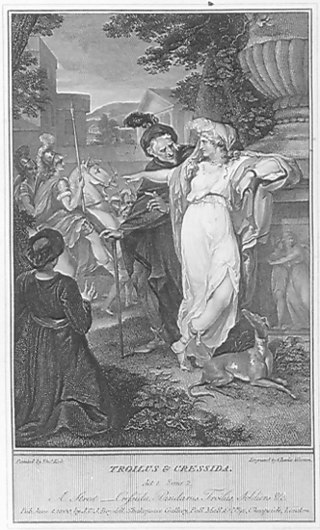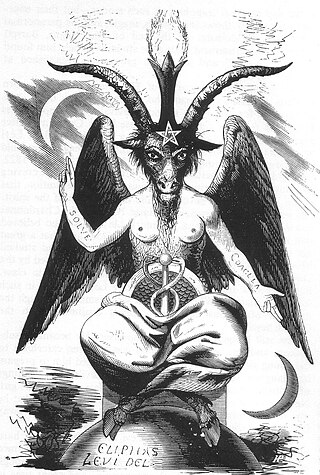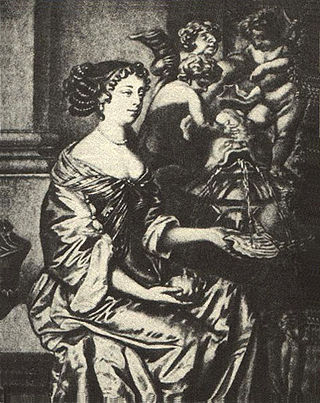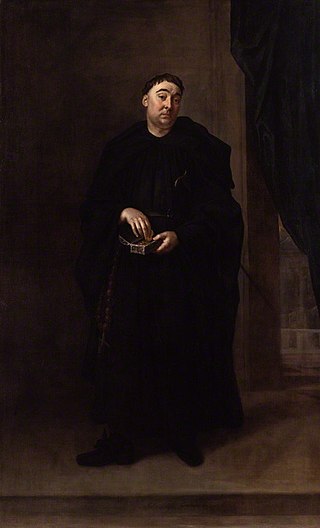
All's Well That Ends Well is a play by William Shakespeare, published in the First Folio in 1623, where it is listed among the comedies. There is a debate regarding the dating of the composition of the play, with possible dates ranging from 1598 to 1608.

Pandarus or Pandar is a Trojan aristocrat who appears in stories about the Trojan War.

Xanthippe was an ancient Athenian, the wife of Socrates and mother of their three sons: Lamprocles, Sophroniscus, and Menexenus. She was likely much younger than Socrates, perhaps by as much as 40 years.

Baphomet is a deity which the Knights Templar were accused of worshipping that subsequently became incorporated into various occult and Western esoteric traditions. The name Baphomet appeared in trial transcripts for the Inquisition of the Knights Templar starting in 1307. It first came into popular English usage in the 19th century during debate and speculation on the reasons for the suppression of the Templar order. Baphomet is a symbol of balance in various occult and mystical traditions, the origin of which some occultists have attempted to link with the Gnostics and Templars, although occasionally purported to be a deity or a demon. Since 1856 the name Baphomet has been associated with the "Sabbatic Goat" image drawn by Éliphas Lévi, composed of binary elements representing the "symbolization of the equilibrium of opposites": half-human and half-animal, male and female, and good and evil. Lévi's intention was to symbolize his concept of balance, with Baphomet representing the goal of perfect social order.

"The Knight's Tale" is the first tale from Geoffrey Chaucer's The Canterbury Tales.

Mohammedan is a term for a follower of Muhammad, the Islamic prophet. It is used as both a noun and an adjective, meaning belonging or relating to, either Muhammad or the religion, doctrines, institutions and practices that he established. The word was formerly common in usage, but the terms Muslim and Islamic are more common today. Though sometimes used stylistically by some Muslims, a vast majority consider the term archaic or a misnomer.
Queen Mab is a fairy referred to in William Shakespeare's play Romeo and Juliet, where "she is the fairies' midwife". Later, she appears in other poetry and literature, and in various guises in drama and cinema. In the play, her activity is described in a famous speech by Mercutio published originally in prose and often adapted into iambic pentameter, in which she is a miniature creature who performs midnight pranks upon sleepers. Being driven by a team of atomies, she rides her chariot over their noses and "delivers the fancies of sleeping men". She is also described as a midwife to help sleepers "give birth" to their dreams. Later depictions have typically portrayed her as the Queen of the Fairies.

Triglav was the chief god of the Pomeranian and probably some of the Polabian Slavs, worshipped in Szczecin, Wolin and probably Brenna. His cult is attested in several biographies of the bishop St. Otto of Bamberg in the years immediately preceding his suppression of it in 1127.

Troilus is a legendary character associated with the story of the Trojan War. The first surviving reference to him is in Homer's Iliad, composed in the late 8th century BCE.

Bardolatry is excessive admiration of William Shakespeare. Shakespeare has been known as "the Bard" since the eighteenth century. One who idolizes Shakespeare is known as a bardolator. The term bardolatry, derived from Shakespeare's sobriquet "the Bard of Avon" and the Greek word latria "worship", was coined by George Bernard Shaw in the preface to his collection Three Plays for Puritans published in 1901. Shaw professed to dislike Shakespeare as a thinker and philosopher because Shaw believed that Shakespeare did not engage with social problems as Shaw did in his own plays.
Elizabeth Boutell, was a British actress.
Philostrate is a fictional character in a number of literary works, including William Shakespeare's A Midsummer Night's Dream (1596). In that play, he is the Master of the Revels at Theseus' court, meaning he is in charge of his lord's entertainments, making recommendations to Theseus, as well as altering the text of some of the plays performed in his court. Shakespeare may have used this character to poke fun at play censorship in London at the time. In early performances of the play, the actor who played this character probably also played the part of Egeus, Hermia's strict father. There is only one scene in act V where both Egeus and Philostrate are present, and in this scene Egeus' character would have taken all of Philostrate's lines as his own.
Mahound and Mahoun are variant forms of the name Muhammad, often found in medieval and later European literature. The name has been used in the past by Christian writers to vilify Muhammad. It was especially connected to the demonization of Muhammad as inspiring a false religion.
In contrast to the views of Muhammad in Islam, the Christian views on him stayed highly negative during the Middle Ages for over a millennium. At this time, Christendom largely viewed Islam as a Christian heresy and Muhammad as a false prophet.

William Shakespeare's influence extends from theater and literatures to present-day movies, Western philosophy, and the English language itself. William Shakespeare is widely regarded as the greatest writer in the history of the English language, and the world's pre-eminent dramatist. He transformed European theatre by expanding expectations about what could be accomplished through innovation in characterization, plot, language and genre. Shakespeare's writings have also impacted many notable novelists and poets over the years, including Herman Melville, Charles Dickens, and Maya Angelou, and continue to influence new authors even today. Shakespeare is the most quoted writer in the history of the English-speaking world after the various writers of the Bible; many of his quotations and neologisms have passed into everyday usage in English and other languages. According to Guinness Book of World Records Shakespeare remains the world’s best-selling playwright, with sales of his plays and poetry believed to have achieved in excess of four billion copies in the over 400 years since his death. He is also the third most translated author in history.

Mary Saunderson (1637–1712), later known as Mary Saunderson Betterton after her marriage to Thomas Betterton, was an actress and singer in England during the 1660s and 1690s. She is considered one of the first English actresses.

The shrew – an unpleasant, ill-tempered woman characterised by scolding, nagging, and aggression – is a comedic, stock character in literature and folklore, both Western and Eastern. The theme is illustrated in Shakespeare's play The Taming of the Shrew.

Anthony Leigh was a celebrated English comic actor.

Niya is a Lechitic god of the underworld of unknown sex, whose exact functions are unknown. Niya is mentioned together with other gods worshipped by Poles, such as Yesha, Łada, or Devana. Niya's cult may be demonstrated by the sayings "Go to Niye" and "Dwell in Nya" collected by Polish ethnographer Aleksander Brückner. In recent years, the confidence in the authenticity of Niya has increased in the scientific community.
Phasaelis, also spelled Phaisael was a princess of Nabatea, daughter of King Aretas IV Philopatris and the first wife of Herod Antipas, ruler of Galilee and Perea.















